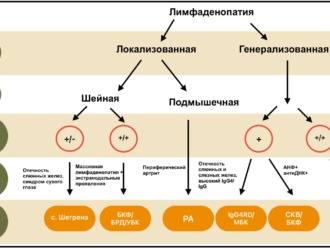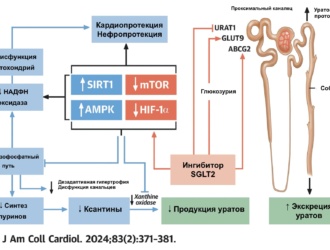
 Введение
Введение
Связь между системной красной волчанкой (СКВ) и инфекцией вируса Эпштейна-Барр (ВЭБ) предполагается уже несколько десятилетий, однако основной механизм влияния ВЭБ на развитие СКВ до сих пор не выяснен.
Методы
Целью данного исследования, включавшего 103 пациента с СКВ и 99 контрольных лиц, было изучение ассоциации параметров ВЭБ-инфекции и СКВ, выяснение того, оказывает ли объединение параметров демографических, клинических и маркеров ВЭБ-инфекции более значимое влияние на развитие СКВ, чем каждый из них в отдельности, а также оценка полиморфизмов генов ВЭБ nuclear antigen 1 (EBNA1) и latent membrane protein 1 (LMP1) в изолятах от пациентов с СКВ.
Результаты
Комплексные результаты, касающиеся серологических, молекулярных и маркеров последовательности ВЭБ-инфекции у пациентов с СКВ, продемонстрировали 24-кратное повышение вероятности наличия СКВ при наличии антител IgG к анти-EBV-EA(D) (ранний антиген) (ОШ=24,086 95% ДИ ОШ=2,86-216,07, p=0,004). Распределение глюкокортикоидов (p=0,130), противомалярийных (p=0,213) и иммуносупрессивных препаратов (p=0,712) среди пациентов с СКВ с положительным и отрицательным уровнем анти-EBV-EA(D) IgG было одинаковым.
Кроме того, более высокие титры анти-EEBV-EA(D) IgG антител были определены как независимые факторы, ассоциированные с лимфопенией, гематологическими проявлениями СКВ (ОШ=1,041, 95%ДИ ОШ=1,01-1,08, p=0. 025, а более высокий титр анти-CA (вирусный капсидный антиген) IgG антител (ОШ=1,015, 95%ДИ ОШ=1,01-1,03, p=0,019) и положительныый результат антител ревматоидный фактор (РФ) (ОШ=4,871, 95%ДИ ОШ=1,52-15,61, p=0,008) были определены как независимые факторы, связанные с алопецией при СКВ. Наконец, представлены новые данные о полиморфизмах генов EBV EBNA1 и LMP1 при волчанке.
Выводы
Полученные результаты подтверждают необходимость дальнейшего изучения ВЭБ в качестве прогностического маркера и терапевтической цели при волчанке.
Ana Banko, Andja Cirkovic, Rada Miskovic, Ivica Jeremic, Milka Grk, Milica Basaric, Ivana Lazarevic, Sanvila Raskovic, Aleksa Despotovic, Danijela Miljanovic
Frontiers in Immunology. Volume 14, 1307589. December 2023
Epstein-Barr virus infection as potential indicator of the occurrence and clinical presentation of systemic lupus erythematosus
Introduction:
The relationship between Systemic lupus erythematosus (SLE) and Epstein-Barr virus (EBV) infection has been suggested for decades, but the underlying mechanism of the EBV influence on SLE development remains to be elucidated.
Methods:
The goals of this research, which included 103 SLE patients and 99 controls, were to investigate the association of the parameters of EBV infection and SLE, to explore whether pooled demographic, clinical and EBV markers achieve a more significant effect on SLE development than each of them individually, and to evaluate EBV nuclear antigen 1 (EBNA1) and latent membrane protein 1 (LMP1) gene polymorphisms in isolates from SLE patients.
Results:
Comprehensive results related to serological, molecular and sequence markers of EBV infection in SLE patients demonstrated even 24 times higher possibility of having SLE if there is the presence of anti-EBV-EA(D) (early antigen) IgG antibodies (OR=24.086 95%CI OR=2.86-216.07, p=0.004). There was the same distribution of glucocorticoids (p=0.130), antimalarials (p=0.213), and immunosuppressives (p=0.712) in anti-EBV-EA(D) IgG positive and negative SLE patients.
Further, higher anti-EBV-EA(D) IgG antibodies titers were identified as independent factors associated with lymphopenia, hematological SLE manifestation (OR=1.041, 95%CI OR=1.01-1.08, p=0.025, while a higher titer of anti-CA (viral capsid antigen) IgG antibodies (OR=1.015, 95%CI OR=1.01-1.03, p=0.019) and positive RF (rheumatoid factors) (OR=4.871, 95%CI OR=1.52-15.61, p=0.008) were identified as independent factors associated with alopecia within SLE. Finally, novel data on EBV EBNA1 and LMP1 gene polymorphisms in lupus are reported.
Conclusion:
The results support further investigation targeting EBV as a prognostic marker and therapeutic goal for lupus.





